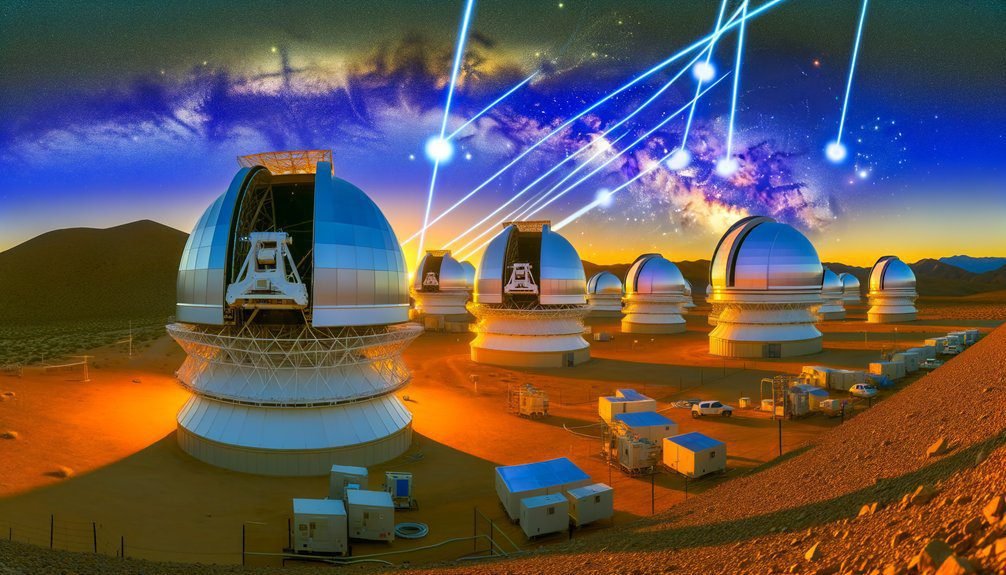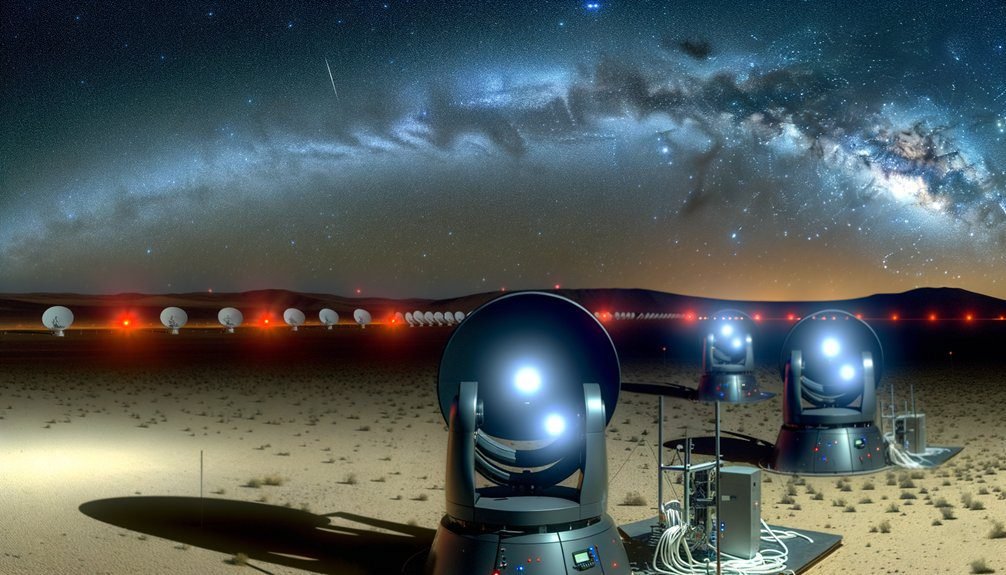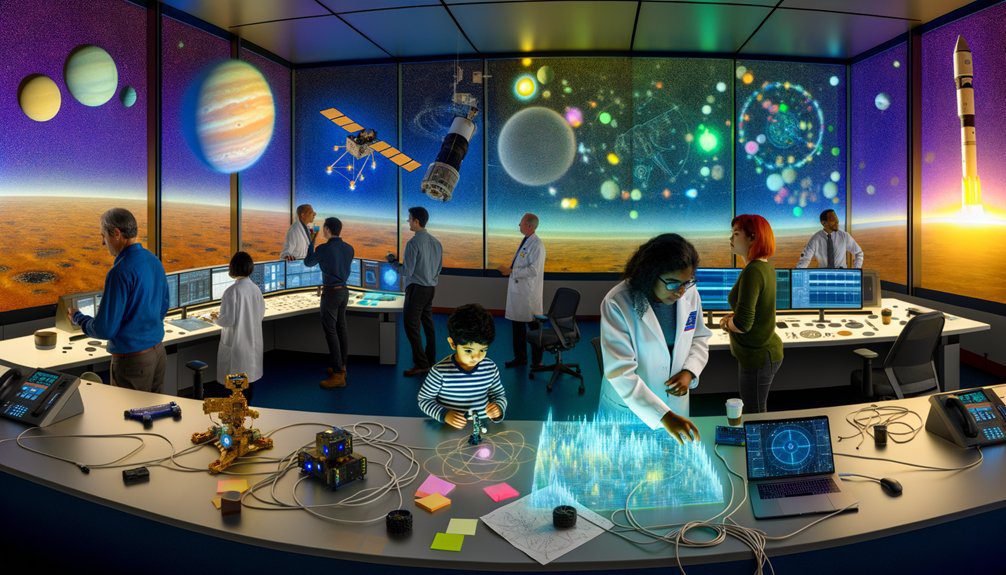You’ll soon get far better telescopes, smarter AI, and focused missions that together raise the odds of finding life or technology beyond Earth. Upgraded radio and optical arrays plus space telescopes cut noise and open new spectral windows for artificial signals and waste heat. Wide all-sky surveys and machine learning will flag faint, transient anomalies fast. Targeted exoplanet spectroscopy seeks biosignature gases and surface clues. Cross-field teams and citizen science speed validation — keep going to learn how each tool helps.
Key Takeaways
- Improved space telescopes will access ultraviolet to infrared bands without atmospheric noise, revealing artificial compounds and planetary waste heat.
- Advanced radio arrays and upgraded optics greatly increase sensitivity and frequency coverage for detecting faint technosignatures.
- Coordinated all-sky monitoring and real-time AI spotting enable fast detection and verification of transient or narrowband signals.
- Targeted exoplanet spectroscopy and temporal monitoring can identify biosignature gases, surface changes, and seasonal biological cycles.
- Small precursor probes and prototype interstellar missions will test in-situ sensors and communication methods for future detailed exploration.
Advanced Radio and Optical Observatory Upgrades

Because signals—both intentional and accidental—can hide in plain noise, upgrading radio and optical observatories is the next practical step in the hunt for extraterrestrial intelligence. You’ll find radio signal advancements sharpen frequency resolution and broaden bandwidth, letting you separate faint, narrowband beacons from terrestrial interference. Optical sensitivity enhancements increase photon collection and reduce noise, so you can detect brief, low-fluence flashes that might be technosignatures. Combining datasets across disciplines—astronomy, signal processing, and atmospheric science—helps you distinguish astrophysical transients from human-made artifacts. Evidence-focused campaigns prioritize reproducible detections: repeated observations, independent verification, and statistical significance thresholds. You’ll appreciate modular upgrades too: phased-array receivers, superconducting detectors, and adaptive optics that improve temporal and spectral fidelity without replacing entire facilities. Operationally, coordinated networks and open data standards let you cross-check candidates quickly. These pragmatic improvements don’t promise immediate contact, but they substantially raise the odds of recognizing an anomalous signal if one’s really out there.
Space-Based Telescopes Targeting Technosignatures
Upgrading ground-based radio and optical assets sharpens our ability to spot technosignatures, but putting telescopes in space removes atmosphere-driven noise and opens spectral windows you can’t access from Earth. You’ll gain steadier point spread functions for exoplanet imaging, enabling coronagraphs and starshades to suppress starlight and reveal faint, structured light that could indicate engineered sources. Space platforms also give you continuous access to ultraviolet and infrared bands where artificial compounds or waste heat might appear.
You’ll rely on interdisciplinary methods: optical engineering, signal processing, atmospheric chemistry and astrobiology converge to interpret anomalies. Rigorous signal filtering aboard satellites reduces false positives from cosmic rays and spacecraft artifacts before downlink. Data fusion with ground arrays sharpens localization and context without duplicating survey-style all-sky monitoring. As missions refine sensitivity and calibration, you’ll move from speculative signatures toward testable hypotheses about technological activity on exoplanets and in interstellar space.
Deep-Survey All-Sky Monitoring Networks

When you stitch together wide-field optics, phased-array radio dishes, and automated transient pipelines, you create a deep-survey all-sky monitoring network that can catch faint, rare, or fleeting technosignatures across the sky. You’d use coordinated deep sky surveys to map persistent anomalies and temporal deviations, combining optical, infrared, and radio bands so nothing obvious slips through the gaps. This approach borrows methods from geodesy, signal processing, and celestial navigation to tie detections to precise sky coordinates and orbital frames. Evidence comes from pilot programs that have flagged fast transients and unusual narrowband emissions; scaling those gives statistical power to separate noise from candidate signals. You’d prioritize wide coverage, cadence optimization, and cross-validation between independent instruments to reduce false positives. The interdisciplinary setup—engineering, astrophysics, and observational statistics—means you’re not guessing: you’re building a reproducible search that can both discover unexpected technosignatures and quantify non-detections to refine future missions.
Artificial Intelligence and Machine Learning for Signal Detection
If you want a search that actually finds faint, novel, or fleeting technosignatures, you’ll need AI and machine learning to sift through petabytes of noisy, heterogeneous data faster and more consistently than humans can. You’ll rely on advanced signal processing to extract weak patterns buried in interference, and on algorithm optimization to prioritize promising candidates without bias. Models trained on simulated and archival data help you generalize to unknown signal types, while interpretable architectures let you interrogate why a detection was flagged. Cross-disciplinary input—from astrophysics to statistics to computer science—keeps methods grounded in evidence and testable assumptions.
- Use supervised and unsupervised learning to reveal unexpected features
- Implement real-time anomaly detection for transient events
- Combine domain-aware preprocessing with robust signal processing pipelines
- Apply algorithm optimization to balance sensitivity and false-alarm rates
- Validate findings with simulated injections and human review
This approach makes your search scalable, transparent, and repeatable.
Targeted Searches of Exoplanet Atmospheres and Surfaces

You’ll want to prioritize targeted observations that can pick out biosignature gases like oxygen or methane while also mapping surface reflectance to identify water, vegetation analogs, or mineral markers. Combine spectroscopy, high-contrast imaging, and photometric monitoring to track temporal variability that could reveal seasonal cycles, weather, or transient technosignals. Cross-disciplinary analysis — atmospheric chemistry, remote sensing, and time-series statistics — will keep interpretations evidence-driven and testable.
Biosignature Gas Detection
Because gases in a planet’s atmosphere carry fingerprints of chemistry and life, targeted searches for biosignature gases let you probe worlds light-years away with pragmatic rigor and interdisciplinary tools. You’ll use spectroscopy, models, and lab experiments to do biosignature analysis that links atmospheric composition to plausible biology while ruling out abiotic false positives. Missions will combine telescopes, retrieval algorithms, and comparative planetology so you can weigh evidence quantitatively.
- High-resolution transit and direct-imaging spectra to detect trace gases
- Bayesian retrievals that quantify confidence in detections
- Laboratory reaction networks to test nonbiological pathways
- Cross-disciplinary datasets (geology, stellar activity, climate models)
- Planned instruments tuned for methane, oxygen, ozone, and sulfur species
This approach keeps claims cautious, testable, and guided by measurable predictions.
Surface Reflectance Mapping
Atmospheric gases tell part of the story, but surface reflectance mapping gives you a different, often more direct window into planetary processes and potential biosignatures by measuring how light bounces off oceans, soils, vegetation-like pigments, and mineral coatings. You’ll combine spectroscopy, imaging, and models to infer surface composition and link reflectance features to planetary geology and possible biological pigments. By comparing laboratory spectra of minerals and organics with telescope data, you can distinguish sand, clay, ice, or photosynthetic-like pigments even across light-scattered atmospheres. Interdisciplinary teams — astronomers, geologists, chemists, ecologists — will weigh uncertainties, calibration, and contextual geology to avoid false positives. Surface maps complement atmospheric measurements, narrowing targets for follow-up and strengthening evidence for habitable or inhabited worlds.
Temporal Variability Monitoring
When you monitor temporal variability, you’re looking for changes over time—short-term flickers, seasonal cycles, or long-term trends—that can reveal dynamic processes in atmospheres and on surfaces that single snapshots miss. You’ll track temporal fluctuations to distinguish weather, geology, and potential biosignatures from instrument noise or transient cosmic events. By combining spectroscopy, photometry, and climate models, you test hypotheses and prioritize targets for deeper study. This approach links astronomy, atmospheric science, and planetary geology, and it’s guided by repeatable evidence.
- Regular lightcurve monitoring to catch transient signals
- Spectral time series to spot changing molecular bands
- Multi-wavelength campaigns to rule out stellar variability
- Seasonal mapping to detect surface or atmospheric cycles
- Correlating events with known cosmic events for context
Interdisciplinary Collaboration and Citizen Science Integration

You’ll get more rigorous answers when astronomers, chemists, biologists, and data scientists form cross-field research teams that frame hypotheses and share reproducible methods. You can also tap public-powered data analysis to scale pattern recognition and flag anomalies in large datasets, provided contributions are validated and versioned. How will you design workflows and incentives that keep citizen input scientifically useful and traceable?
Cross-Field Research Teams
Because discovering extraterrestrial life touches so many domains, building cross-field research teams is essential: you need astrophysicists, biologists, chemists, engineers, social scientists, and skilled citizen scientists working from a shared evidence framework to spot, validate, and interpret signals that any single discipline could miss. You’ll benefit when cross disciplinary collaboration shapes hypotheses, experimental design, and transparent data standards, and when research funding supports sustained, diverse teams. You’ll ask better questions, reduce bias, and accelerate confirmation or refutation of candidate biosignatures.
- Shared protocols for signal validation that everyone understands
- Rotating expertise so fresh perspectives challenge assumptions
- Joint training to align methods and terminology
- Transparent data curation to enable reproducible checks
- Funding models that prioritize interdisciplinary longevity
Public-Powered Data Analysis
As citizen scientists and domain experts pool their skills and curiosity, public-powered data analysis becomes a force multiplier for spotting, classifying, and vetting anomalous signals that automated pipelines might miss. You’ll contribute through crowdsourced analytics projects that break large datasets into tractable tasks, letting pattern-recognition strengths of humans complement machine learning. By working on open source platforms, you can inspect code, reproduce results, and iteratively improve algorithms with diverse expertise — astronomers, statisticians, programmers, and hobbyists. Evidence from recent projects shows volunteers flag subtle features and reduce false positives when guided by clear protocols and training. You’ll need transparent metadata, versioned datasets, and validation workflows so contributions scale reliably. That blend of inclusivity and rigor accelerates discovery while keeping science accountable.
Novel Probes and Interstellar Precursor Missions
Someone curious about signs of life beyond our solar system will want to know how novel probes and interstellar precursor missions are pushing the boundaries of detection, sampling, and communication before we commit to full-scale interstellar travel. You’ll learn how small, targeted missions test hardware, refine novel propulsion concepts, and validate interstellar communication strategies so later, larger efforts aren’t flying blind. These precursors gather in-situ data on particle environments, test autonomous science algorithms, and return lessons about contamination control and sampling fidelity. You’ll see interdisciplinary teams—engineers, astrobiologists, data scientists—use empirical results to prioritize biosignatures and instrument designs. The evidence-driven progress reduces risk while expanding what’s detectable at distance.
Small precursor missions test propulsion, sensors, autonomy, and contamination control—building evidence-based tools for future interstellar biosignature searches
- Demonstration of novel propulsion approaches at small scale
- Prototype sensors for targeted biosignature detection
- Autonomous decision-making for scarce-data environments
- Tests of interstellar communication protocols and encoding
- Contamination control and sample-return feasibility studies
Frequently Asked Questions
How Will Alien Discoveries Affect Global Politics and Religion?
About 72% of people say they’d want disclosure, so you’ll picture widespread attention and quick shifts. You’ll see alien diplomacy emerge—new protocols, coalitions and legal frameworks—while state power balances may realign. Religions will spark extraterrestrial theology debates, blending scripture with scientific evidence; some followers’ll adapt, others resist. You’ll witness interdisciplinary research guiding policy, cautious evidence-focused statements, and slow, negotiated cultural integration rather than instant upheaval.
Could Aliens Already Be Observing Earth Unnoticed?
Yes — it’s plausible you could be observed without knowing it. Thoughtful, evidence-focused inquiry asks whether unnoticed surveillance could use alien technology far beyond ours, like passive sensors or cloaking methods that avoid detection. You’d weigh interdisciplinary clues: anomalous signals, unexplained probes, or statistical oddities in astrophysical data. While no conclusive proof exists, staying curious and rigorously testing anomalies helps you distinguish imagination from genuine, verifiable signs.
What Would Contact Protocols Look Like After Detection?
You’d expect chaos, but contact protocols are painstakingly calm: detection processes trigger verification, multinational review, and staged disclosures to avoid panic. You’ll see scientists, diplomats, ethicists and technologists collaborate, weighing evidence, establishing communication norms, and protecting biosafety. Decisions follow peer-reviewed checks, legal frameworks and public engagement plans. You’ll be guided by transparency, caution and curiosity, balancing open science with risk management while endeavoring to learn responsibly from whatever we’ve discovered.
How Would Alien Microbes Impact Earth’s Biosphere?
Alien microbes could reshape Earth’s microbial ecosystems by introducing new metabolisms, genes, or competitive pressures that alter nutrient cycles and food webs. You’d assess risks by integrating microbiology, ecology, planetary protection, and epidemiology, relying on lab experiments and ecological models. Evidence would guide containment, monitoring, and mitigation strategies to prevent harmful invasions while exploring potential benefits like novel enzymes or biotechnologies, always prioritizing thorough, stepwise testing.
Who Owns Any Artifacts Found Beyond Earth?
Right off the bat, no one owns artifacts beyond Earth outright — international treaties and space law frame legal ownership and states’ responsibilities. You’ll find ethical considerations woven in: scientific stewardship, cultural respect, and shared heritage guide access and study. You’ll want interdisciplinary evidence and transparent protocols, since courts, treaties, and consensus may resolve disputes. It’s a curious, evidence-focused terrain where cooperation beats territorial grabs every time.